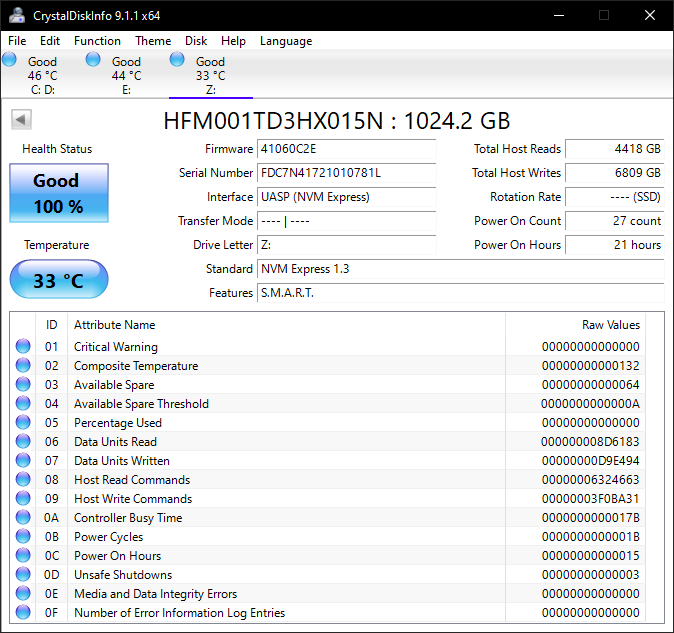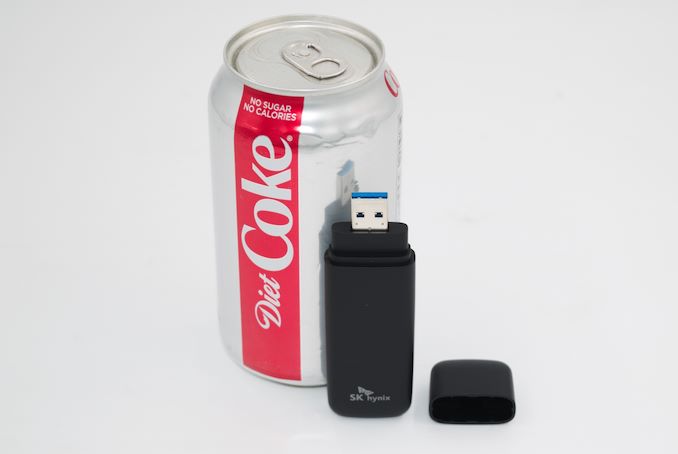SK hynix Tube T31 Stick SSD Review: Bridging Solution Springs A Surprise
by Ganesh T S on April 15, 2024 8:00 AM EST- Posted in
- Storage
- SSDs
- flash
- DAS
- JMicron
- SK Hynix
- USB 3.2 Gen 2
- Portable SSDs
Miscellaneous Aspects and Concluding Remarks
The performance of different stick SSDs in various real-world access traces as well as synthetic workloads was brought out in the preceding sections. We also looked at the performance consistency for these cases. Power users may also be interested in performance consistency under worst-case conditions, as well as drive power consumption. The latter is also important when used with battery powered devices such as notebooks and smartphones. Pricing is also an important aspect. We analyze each of these in detail below.
Worst-Case Performance Consistency
Flash-based storage devices tend to slow down in unpredictable ways when subject to a large number of small-sized random writes. Many benchmarks use that scheme to pre-condition devices prior to the actual testing in order to get a worst-case representative number. Fortunately, such workloads are uncommon for direct-attached storage devices, where workloads are largely sequential in nature. Use of SLC caching as well as firmware caps to prevent overheating may cause drop in write speeds when a flash-based DAS device is subject to sustained sequential writes.
Our Sequential Writes Performance Consistency Test configures the device as a raw physical disk (after deleting configured volumes). A fio workload is set up to write sequential data to the raw drive with a block size of 128K and iodepth of 32 to cover 90% of the drive capacity. The internal temperature is recorded at either end of the workload, while the instantaneous write data rate and cumulative total write data amount are recorded at 1-second intervals.
| Sequential Writes to 90% Capacity - Performance Consistency | |
| TOP: | BOTTOM: |
 |
|
 |
|
The apparent SLC cliff for the SK hynix Tube T31 1TB version is around 400GB, after which write speeds drop down from 1000 MBps to around 240 MBps. The drive is able to sustain advertised write speeds for around 400s. The temperature at the end of the process is only 53C, but that is probably aided by the fact that the last 500GB of writes was done at only 240 MBps. Overall, the performance profile is more than satisfactory for casual users. Other than the initial load up of content, it is highly unlikely for users to write more than 400 GB in one shot into a 1TB drive. The SLC cache is unlikely to be exhausted for most write workloads, and the amount is way higher than what is present in other stick SSDs.
Power Consumption
Bus-powered devices can configure themselves to operate within the power delivery constraints of the host port. While Thunderbolt ports are guaranteed to supply up to 15W for client devices, USB 2.0 ports are guaranteed to deliver only 4.5W (900mA @ 5V). In this context, it is interesting to have a fine-grained look at the power consumption profile of the various external drives. Using the ChargerLAB KM003C, the bus power consumption of the drives was tracked while processing the CrystalDiskMark workloads (separated by 5s intervals). The graphs below plot the instantaneous bus power consumption against time, while singling out the maximum and minimum power consumption numbers.
| CrystalDiskMark Workloads - Power Consumption | |
| TOP: | BOTTOM: |
 |
|
 |
|
The SK hynix Tube T31 has a peak power consumption in the CrystalDiskMark workloads of 4.27W. This is 2x to 3x of the numbers seen in other stick SSDs, and approximately the same as the only other bridge-based PSSD in the mix. SK hynix's controller and NAND flash are reputed for their low power consumption, and despite the DRAM in the package, the numbers are similar to that of the DRAM-less bridge-based Silicon Power PX10 PSSD. It is also heartening to see a low-power idle state (0.02W) that is helpful when the stick SSD is used with battery-powered hosts.
Final Words
The SK hynix Tube T31 was introduced into the market a couple of months after the Beetle X31. Both external SSDs use the same core - the SK hynix BC711 OEM SSD. SSD prices are slowly on the rise, thanks to the rebound in the flash market. Unfortunately, that also means prices for SSDs are not going to be consistent across different retailers. The 1TB SKU is for sale on Newegg at $85 and Amazon at $100. SK hynix also has a 512GB variant that is priced at $70 (Newegg) / $80 (Amazon). Prices of all PSSDs are in a flux and it is not possible to make any comments on the value proposition (either standalone or on a comparative basis) of the Tube T31 at this point in time.
A fully plastic enclosure for a board with such high power consumption (and, as a result, higher thermal load) is not preferable. Even if part of the casing were to be made of metal, complaints of smelly plastic under high load / case warmth could be avoided. Despite being advertised as a stick SSD, the casing is quite bulky and bound to cause port congestion in most systems if nearby USB ports are also occupied. The Type-A only nature could be a deal-breaker for some systems, but we found the drive to work with advertised specifications even with off-the-shelf USB 3.2 Gen Type-A to Type-C adapters (including the adapter bundled with the Silicon Power MS70). The connector-protecting cap is not attached to the main section of the casing. Some thumb drives allow for the cap to be attached to the rear end when the drive is in active use, but the Tube T31 has no such feature. As such, some users may end up misplacing the cap.
Stick SSDs with bridge-based internals are rare, and rightly so - there are power consumption, BOM cost, and thermal design challenges involved that are largely solved by going in for a native flash controller. The SK hynix Tube T31 is able to address aspects such as BOM cost by integrating the DRAM, SSD controller, and NAND flash in a single package. However, power numbers are still too high for a thumb drive. This tight integration also means that SK hynix only markets two capacity points for the Tube T31 - 512GB and 1TB. On the performance front, the drive performs in an excellent manner (as advertised) as long as the workload set is kept within reasonable numbers for both reads and writes.

6.8TB+ writes, and 4TB+ reads at the end of our testing routine
The SLC cache size (40% of user capacity in our 1TB review sample out of the box) is quite high for a stick SSD / thumb drive. For casual users, this results in satisfactory performance for normal workloads. The Tube T31 is a unique stick SSD considering the fact that it is the only one we are aware of with a DRAM-equipped internal SSD. This enables the thumb drive to provide class-leading true SSD performance for workloads such as OS booting and office document work involving large number of random accesses.
The SK hynix BC711 is a nifty M.2 2242 SSD (it even has a M.2 2230 avatar, thanks to the integration of all necessary SSD components in a single package). In PSSDs such as the Beetle X31, it is easy to recommend. On the contrary, its characteristics make it a bit of a mixed bag for the thumb-drive form factor. Make no mistake - the performance benefits are quite welcome, but we would have liked it better in a more suitable casing with optimized power consumption numbers.











15 Comments
View All Comments
meacupla - Tuesday, April 16, 2024 - link
Sir, it's using a JMS583 bridge chip.It is the worst NVMe-to-USB bridge chip.
There is literally nothing else that performs worse.
It's also capped at 10Gbps (1000MB/s) peak and the SLC cache runs out at 400GB written.
I don't think it's possible to lose at silicon lottery any worse than this. Reply
PeachNCream - Tuesday, April 16, 2024 - link
Be patient - the industry never ceases to find a way to do worse. ReplyTheinsanegamerN - Thursday, April 18, 2024 - link
I can think of a way. This drive is TLC.So, we COULD swap in some QLC for good measure.... Reply
ballsystemlord - Friday, April 19, 2024 - link
You sir, have an evil sense of humor and I like it. ;) ReplyPeachNCream - Saturday, April 20, 2024 - link
That would be a revoltingly OEM thing to do - and well within the realm of possibility.Please don't give them any ideas Reply